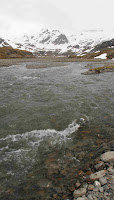
South Georgia government prohibits approaching closer than 200 meters (2 football fields) to the old whaling station because the strong winds can pick off pieces of sheet metal from the old buildings and send them flying. (It seems to be an example of a little overly cautious British Government.) We get fairly close to the old station by zodiac. It has been taken over by fur and elephant seeds and sea birds. We then land and hike back from the beach for more nature. We have to land on a beach with lots of breeding fur seals. The keep the tourists in line and the fur seals in their place, they have set kayaks up to provide a corridor up the beach to an area where the fur seals are less numerous.
During lunch we head to Grytviken--again on the open sea during lunch but today isn’t as bad as Monday. The Norwegians started whaling at Grytviken in 1904 and it changed ownership a number of times--ending with a two year lease to a Japanese company that was trying to develop a market for frozen whale meat. They were not successful because most of the whales had already been killed. This is also where Sir Ernest Shackleton died of a massive heat attack at the start of an expedition he launched in the 1920s. He is grave is here and we visit it and toast him with a shot of rum. Steve (the naturalist who also specializes in history) gives Shackleton a great tribute. The passenger who is the trumpet player played Bramhs (spelling?) Lullaby at gravesite. I thought that was a strange choice but we learn at the wrap-up that it is the same song that was played on banjo by one of Shackleton’s crew at Shackleton’s funeral. There are a number of people on this trip who came specifically because they are Shackleton history buffs so this is a very significant stop for them.
The museum here includes a lot of information on Shackleton (including a recreation of the 23 foot lifeboat he used to sail sail the 800 miles from Elephant Island to here), information on whaling history and natural history. It also includes history of the Falkland war (Argentina invaded South Georgia and occupied the research station, government offices and old whaling station for about two weeks.) It is a really good small museum in the middle of nowhere. Much of this whaling station has
been torn down for safety but we are allowed to walk around the remaining buildings (which have been stabilized). Whaling ended here in 1965.

In the last few years of whaling they seem to have made use of much of the animal (not just the blubber for oil). Some of the pictures are pretty gruesome. It turns out that if you ate margarine in the 1950s or early 1960s, you were eating hydrogenated whale oil.
Evening wrap-up: Some great stories about the Shackleton expedition but the highlight is a presentation by the staff from the South Georgia government and the British Antarctic Research facility. Some interesting random facts:
- To reduce their carbon footprint, the government/research station has re-commissioned an old hydro electric dam built by the Norwegians years ago. It now produces enough power for the research facility, government offices and museum--about 300 kilowatts. They just started using it a month ago so they haven’t used it through the winter but expect it to work year around--totally eliminating the need for diesel fuel for heating and electricity.
- There is concern that the amount of krill in the ocean around South Georgia significantly dropped last year. The drop was caused by a shift in the location of the Antarctic Convergence (where the warm and cold oceans meet) to south of South Georgia. This resulted in warmer, less nutrient rich waters around the island. With the reduction in food, there has been a reduction in fur seals breading and the Gentoo penguins on South Georgia failed to raise chicks last year. This looks like a temporary situation, the Antarctic Convergence has moved back north and the penguins are mating this year. However, with climate change it may be happening more often than in the past.
- The government actively manages the fishery to the territorial limit of 200 miles around South Georgia and the South Sandwich Islands. Commercial fishing licenses fund the enforcement that includes observers on all the fishing ships. They actively control the catch and the methods (e.g. bottom trawling is strictly prohibited). The South Georgia tooth fish (also known as Patagonian tooth fish, Antarctica sea bass and Chilean sea bass is certified by the Marine Stewardship Council as a sustainable, well regulated fishery (check for the marine council logo).



No comments:
Post a Comment